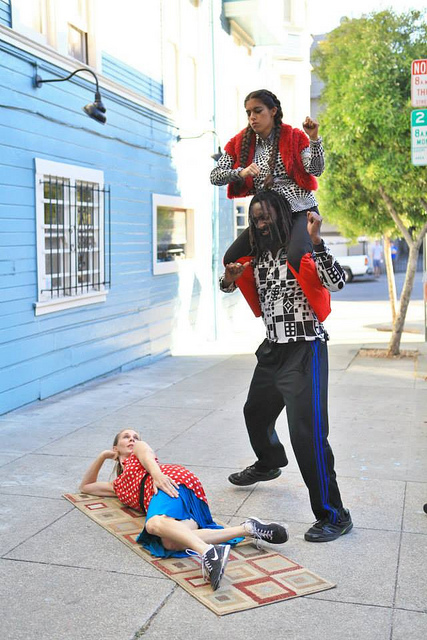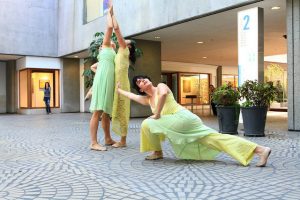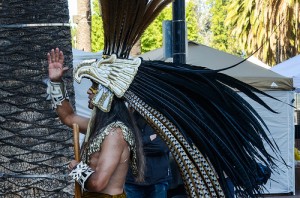Terrific Site-Specific: San Francisco Trolley Dances
If Rin Tin Tin and Lassie conspired to choreograph a dance it might be as smart and rambunctious as Kim Epifano’s Dog Shop, performed outside a pet grooming shop at 14th and Belcher in San Francisco.
The dance was one of seven performances in the site-specific adventure Trolley Dances that began near the Embarcadero Plaza last weekend.
In Dog Shop, dancers Antoine Hunter, Zoe Klein and Jennifer Perfillio galloped up and down the uneven sidewalk, wrestled, and chased each other with a freedom usually reserved for country dogs. They took turns peeking through the opening in a folding chair, much like a pooch at a swinging doggie door. It became clear though, that one of the critters was a cat. An adorable yet aloof teaser, she scampered up into a nearby tree.

Antoine Hunter, Zoe Klein and Jennifer Perfillio in Dog Shop outside Little Ark Grooming Shop.
Epifano and Julie Wolf sang bluesy songs driven by Wolf’s acoustic guitar – everyone knows that dogs and cats prefer the blues – and the gritty score fit the neighborhood. So did the movement.
Dancers were not trying too hard to be animals, though we loved those hints of animal locomotion. Epifano kept the pawing and eye flashing subtle. The real strength of the work was its connection to the street and surrounding environment.
Now in its 10th year, Trolley Dances is presented by Epifano’s Epiphany Productions for two days in October, mostly along different parts of the MUNI lines. She got the idea from Jean Isaacs, who created the first Trolley Dances 15 years ago in San Diego with her San Diego Dance Theater. The two women have collaborated on many Trolley installations. A few weeks before the SF run, Epifano created and performed a work inspired by the history and architecture of Chicano Park; the result was a surreal circus for two dancers amidst giant murals on giant bridge pillars of the San Diego-Coronado Bay Bridge.
In their traditional trade, Isaacs traveled north to San Francisco to set a work outside the entrance of Embarcadero #2. The fascinations in Chaos and Order were then the contrasts of light and shadow, sharp-edged skyscrapers and smooth skinned dancers. Set to a thrilling score – O Magnum Mysterium by Ola Gjeilo – dancers Katie Griffin, Lauren Slater, and Sondra Kazama zoomed and rebounded. They pulled their palms backward, as if responding to a powerful wind. Poses seemed to mirror paintings in a window. Costumes, in muted shades of yellow and green, suggested still-life paintings.

Katie Griffin, Lauren Slater, and Sondra Kazama in Chaos and Order. Photo credit: Yvonne Portra
The tour began at Justin Hermann Plaza near the Embarcadero. David Vargas and the Tezkatlipoka Aztec Dance and Drum group performed traditional dances that complemented the Busker atmosphere of the area. You couldn’t miss the drumming or headdresses –three-foot plumes of feathers sprouting out of cylinders.
Warning viewers not to try it at home, Vargas performed a fire dance, first dipping his bare feet into a flame, and then his bare, and hair-less thigh.

David Vargas in Tezkatlipoka Aztec Dance. Photo credit: Daniel Lane
The body music troupe Keith Terry & Corposonic greeted viewers at the Church/Market MUNI Station underground platform with highly complex rhythmic slapping and stomping. Their a cappella singing played with odd-time signatures and made viewers forget about the roaring train noise. Imagine the headache they suffered after several hours under there for two days.
The mission of Trolley Dances, which has annual performances in San Francisco, San Diego, and Riverside, is to develop dynamic dance that is relevant and engaging, and accessible to the public. Audience members get on a trolley or train at a designated station and follow guides to various stops along the route. They encounter short performances, each about 10 minutes long. The idea is to take viewers on an adventure, to see dance by different choreographers in unexpected places, and discover their own city.
Choreographers are asked to investigate the land, history, architecture, or cultural matrix of a site. Their dances often inspire deep reflection.
Viewers hiked on a muddy path to a wooded area for a dance at Sue Bierman Park. The grass was wet and to our left, tucked away in the shrubs, was a makeshift tent. Clearly, there was a human being sleeping under there. Was that part of the performance? No, and yes.
Shinichi Iova-Koga’s Trees involved trees. Eight men and women slowly emerged from behind trees and rose up out of the brush. Two men played mouth organs, which seemed to beckon more to come out. Movement was achingly slow in the realm of Butoh, and dancers slithered over the mud and wet leaves.
One could imagine them as wild animals, tiny forest creatures, reptiles, amphibians. The climax was seeing them raise a small tree branch higher and higher. Still, the overwhelming hit, the takeaway, was the awareness that homeless people live in the trees just a few feet away.
In sharp contrast, hyper-disciplined martial artists inside Maru Doju on 14th Street demonstrated Aikido and other techniques. Viewers flinched during body slams and squirmed at each finger bent back too far. Led by Ray Feliciano, the performers grabbed everyone’s attention with their physical strength and humble bows.
Site-specific dance is created to exist in a chosen place, and Lizz Roman and Dancers made us engage with a very dull place in a memorable way. Julie Wolf continued playing her guitar outside Little Ark Grooming Shop, and everyone followed her several blocks to IBEW, the Local 6 Electricians Union on the corner of Fillmore and Hermann Streets. Accompanied by the band Watersaw, nine men and women danced on the walls, stairs, and benches. Synthesized voices and deep bass tones rattled our cores, and the dancers responded with stretchy and relentless sequences as if they were plugged into an outlet. We’ll never look at that drab union building the same way again.
Trolley Dances isn’t Ms. Epifano’s only site-specific production. In July, audiences were invited to a tropical paradise of dance inside the Conservatory of the Flowers. In Botany’s Breath, viewers experienced dances while winding through the exquisite plants and flowers. The performance harkened back to Eden and mythical beings. And it amplified the secret nature of gardens, and our awareness of temperature and humidity. When the performance ended, the sweaty crowd ventured out into the shock of cool night air and fog to watch a film projected onto the beloved old building.
It’s easy to think, oh, we’ll just do a dance outside on the side walk, or snake around inside an old gem filled with delicate plants. But one can’t overstate the logistical challenges of performing on a site. The mission is to choose an interesting route, and then cut through red-tape, get permission, and brave the elements.
Over the years, San Francisco Trolley Dances has gone on in heavy rain. San Diego and Riverside installations have endured extreme heat and flaming sun. Those unexpected elements are all part of the experience, to discover and interact with spaces in memorable ways. And this year the weather was perfect.
Trolley Dances photo gallery:
http://www.flickr.com/photos/epiphanydance1/sets/72157636937843115/
Trolley Dances – Jean Isaacs San Diego Dance Theater:
Trolley Dances soars with choir and murals; sparks talk about homeless

Kris Eitland covers dance and theater for Sandiegostory.com and freelances for other publications, including the Union Tribune and Dance Teacher Magazine. She grew up performing many dance styles and continued intensive modern dance and choreography at the Univ. of Minnesota, Duluth, and San Diego State Univ. She also holds a journalism degree from SDSU. Her career includes stints in commercial and public radio news production.
Eitland has won numerous Excellence in Journalism awards for criticism and reporting from the San Diego Press Club. She has served on the Press Club board since 2011 and is a past president. She is a co-founder of Sandiegostory.com. She has a passion for the arts, throwing parties with dancing and singing, and cruising the Pacific in her family’s vintage trawler. She trains dogs, skis, and loves seasonal trips to her home state of Minnesota.
